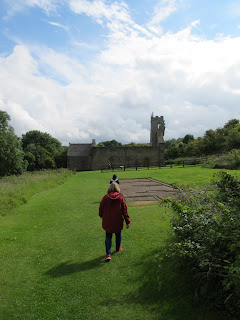Knowing it would be raining most of the morning, we headed to Castle Howard. You may know Castle Howard from the films listed at this link - Brideshead Revisited anyone? - (Castle Howard on screen), but the boys knew it from 'Garfield: a tale of two kitties'.
It is a beautiful stately home. Building began in 1699 and took 100 years to complete. The turquoise drawing room and the Great hall were my favourite part of the house, as was wandering through the formal rose garden (despite the rain), as the flowers were so very fragrant.
 |
| The dinnerware collection |
 |
| ... in close up. |
 |
| The grand hall. Runs the depth of the house. Scene of balls, weddings, receptions, etc. Too large to play a regulation game of indoor cricket though. |
 |
| The family chapel. Redone is highly ornate style by a particularly religious member of the family about 150 years ago. |
 |
| The start of the gardens. |
 |
| Oli and the Castle. |
 |
| Bennie and some weeds. |
Rievaulx Abbey
The Abbey was one of the most wealthiest abbies of England until Henry VIII decided to plunder another piece of gorgeousness to line his coffers in 1538. It was a Cistercian Abbey and is set in a beautiful, hilly, treed setting. It was so peaceful wandering through the ruins - there was a great deal left, so I was certainly left with a mental impression of the place in its peak. The little museum co-located was presented in a style that would please the Cistercian monks - sparse but specific. Items in the museum were carefully chosen to reflect the life of the monks.
 |
| The nave: the western "main hall", where the lay brothers would have their daily service. |
 |
| The chancel: the eastern "private" wing where the monks would have their 8(!) services a day. First one starting at 0300! |
Wharram Percy Deserted Medieval Village
A little out of the way, and at the end of a road, is the car park that led to a 3/4 mile hike to the deserted medieval village.
From Wikipedia:
Although the site seems to have been settled since prehistory, the village appears to have been most active from the 10th to the 12th centuries. The Domesday Book of 1086 records it as 'Warran' or 'Warron'. The suffix 'Percy' stems from the prominent, aristocratic family that owned the area during the Middle Ages.
The Black Death of 1348–49 does not seem to have played a significant part in the desertion of Wharram Percy, although the large fall in population in the country as a whole at that time must have encouraged relocation to larger settlements.
In 1402 or 1403, the Percy family exchanged their holdings in the area with the Hylton family. Following changes in prices and wages during the 15th century, pastoral farming (particularly sheep) was more profitable for landowners than cereal farming. Over the century following, the Hylton family devoted more and more land to sheep, as their employment of agricultural labour decreased. During the early 16th century, the last residents of Wharram Percy were evicted and their homes were demolished to make room for more sheep pasture.[3]























